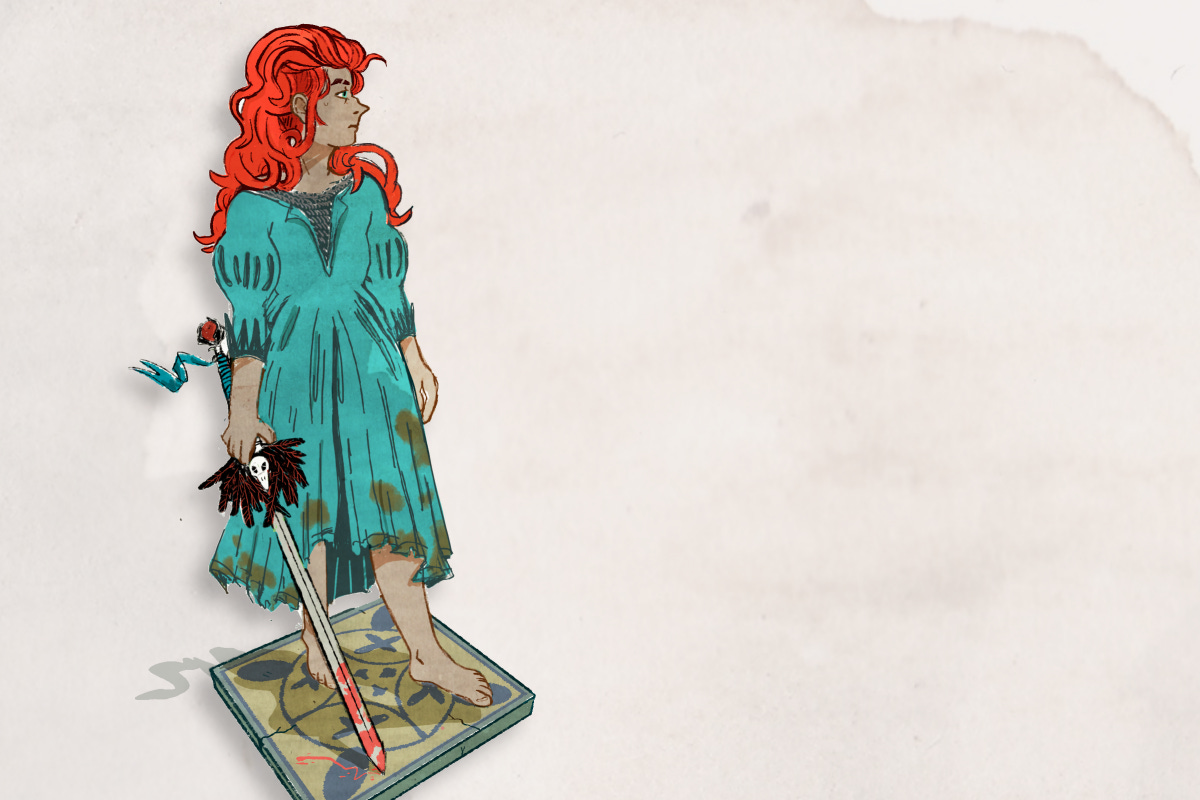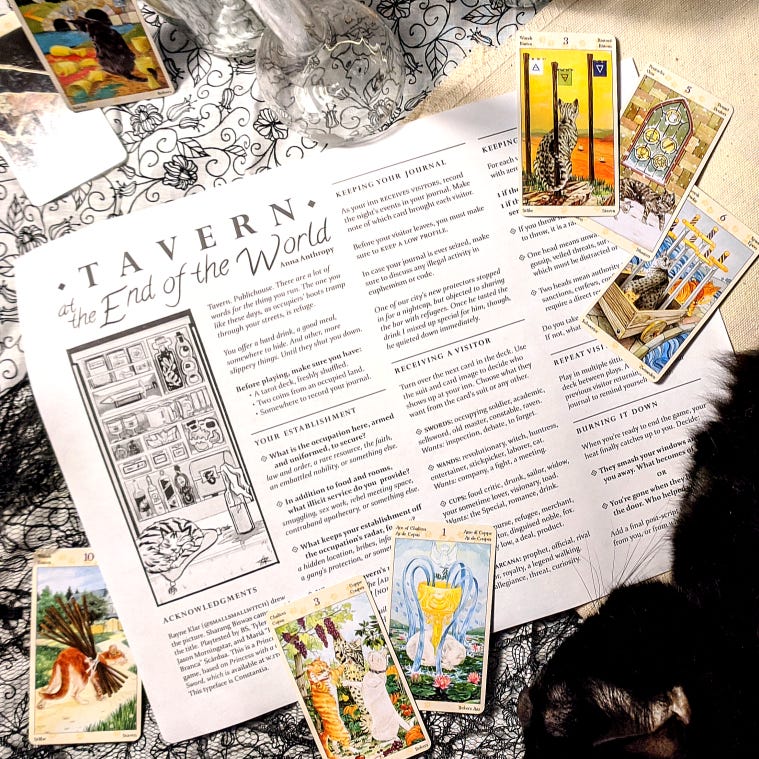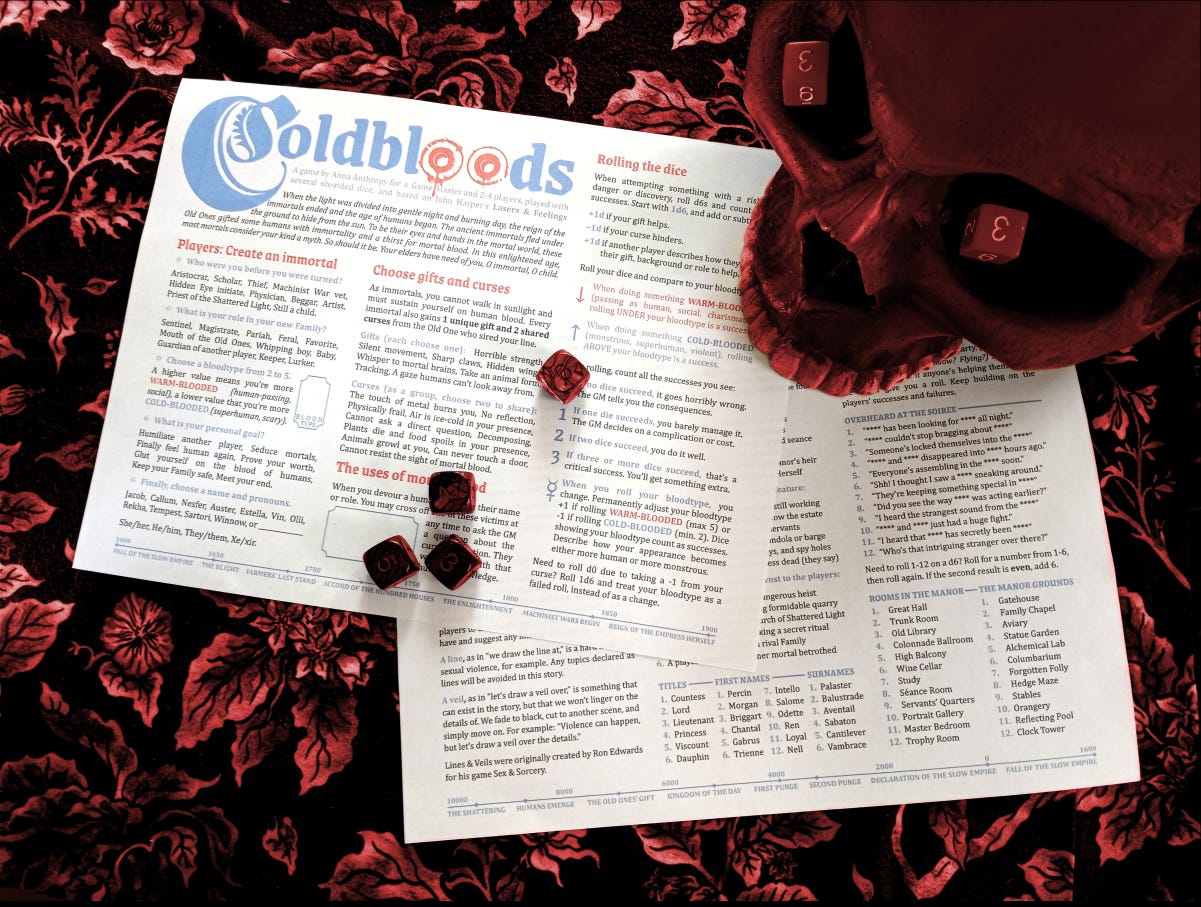Princess with a Cursed Sword Review and Interview with Creator Anna Anthropy
Explore Ruins, face challenges and chill with your sword | The Lone Toad
Welcome again Toad Warriors to another Solo RPG Review.
There really are just way too many Solo RPGs to properly review, as much as I’d like to read and play everyone. Unfortunately, I’m just one frog with a lot of responsibilities and a busy life event happening shortly.
But I like playing and reviewing Solo RPGs, so this week we are taking at look at the one-page Solo RPG, Princess with a Cursed Sword by Anna Anthropy. Princess with a Cursed Sword is consistently in the top 10 Solo RPGs by popularity in Itch.io and currently has 4.89 stars out of 5 (on 100+ ratings) so there has got to be a reason why folk love the game so much. Let’s find out!
Princess with a Cursed Sword Review
🎲 - Princess with a Cursed Sword
✍️ - Designed and written by Anna Anthropy and illustrated by Rayne Klar.
💵 - Pay What You Want on itch.io
🐸 - Solo Built Journaling game
A Sword and a Story
She hears the door to her chamber unlock, the screeching of the bolt against dry metal unmistakable. Rusty hinges wail as the door slowly opens, revealing the next room. She has been in this chamber for many years, in penance to gods she does not believe in.
As she peaks into the next room, she notices on the floor a sword, unadorned but still stained with the dried blood of a hundred crusades. She picks it up and finds she cannot lose it from her grip.
It strikes me as somewhat funny that this post will have several times the word count of Princess with a Cursed Sword. Being only 1 side of one page, Princess can be read and understood in less than five minutes.
You only need three things to play Princess, a Tarot deck (I use a free online one), two coins of any type, and something to record your story. I’d suggest you need something else, a free mind open to imagination. A game with simple mechanics, you can quickly get deeply into the world of the Princess and use it to create your own dramatic story.
Journaling Games
She walks out of the library and not into another room but onto a battlefield. Thousands of warriors clash and battle. The smell of blood and fear disgust the Princess. The screams and shouts fill her ears. She looks down at herself and instead of her simple robes she wears armour, gleaming despite the mud and filth. At her feet is a scared soldier, hardly older than a boy. In her hands is the sword, pointed at the boy’s throat.
The sword hungers for blood. It want’s more death. But it wants to change, to be better. And to be forgiven for its crimes of violence. She resists the killing blow and the boy scrambles away in fear. The battlefield dissolves and she is left in a normal hallway.
While some may feel journaling games are the simplest of Solo RPGs, I always felt they inspired creativity in myself that other types of Solo RPGs don’t (or can’t). Simple oracles or prompts are enough to fire up my imagination. Simple mechanics are enough to give the story a feeling of uncertainty.
What Princess with a Cursed Sword does is gives the player an interesting starting premise. Every game starts the same:
A figure stands in an ancient ruin, bare feet on crumbling stone. Her gown far too fine, her sword much too dark.
From there you answer a few questions related to the gown, why the princess has bare feet, and what the sword seeks. For me, the sword is seeking forgiveness after generations of killing and death. Will my princess be able to help the sword find forgiveness and break the curse?
From here you flip tarot cards which gives you rooms or situations. If there is danger you flip coins, aiming for a heads.
How does it end?
Before the Princess stands a forge, burning with white hot fire. The sword tugs at her hand, as if drawing itself into it. It whispers to her ‘My time is done. Let me be at an end. Let my death be my forgiveness.’
She steps forward and casts the sword into the flame. The souls of a hundred dead leap from it and go to where they can find peace. The sword has been forgiven.
Princess with a Cursed Sword ends when you want it to end. While you can fail certain situations, your character doesn’t die. The goal of the game is for you to create your own dramatic and fantastic story and to find your own ending for the sword and the princess.
Overall if you like journaling games, you’ll love Princess with a Cursed Sword. If you don’t then you probably won’t like it. But even if you’ve never played a journaling game, or a solo RPG, I recommend you print off a copy of Princess, light a candle or two, play some classical music, and see where the story takes you.
Interview with Anna Anthropy
I’m joined with week by Anna Anthropy, who I’ve asked some questions about Princess with a Cursed Sword, other projects based on it and future projects.
Q: Princess with a Cursed Sword creates a really evocative story in just a few short sentences. What was your inspiration behind creating the game?
A: It actually began with another game: Gregor Vuga's A Singular Quest. I used to run this game in one of my classes because it was uniquely suited to a classroom setting: There's basically only one player character, and a group of people contributing to the setting and "GMing." In one of the early sessions of the game, I played a "cursed princess" - chosen from a list of preselected adjectives and nouns.
What could it mean to be a cursed princess? I went with the classic RPG concept of a cursed item that you can't put down after you pick it up - a sword in her case, because I liked the juxtaposition. This character stayed with me long after the play session, and became the seed of Princess with a Cursed Sword.
Q: At a page long, Princess with a Cursed Sword doesn't have many mechanics or traditional RPG systems. How do you craft a full game experience with so few words?
A: I think most good games only have a page or two of rules once you strip out all the pages of setting and lore and tables of random events - things that should be described only gesturally because filling in the details is for the players to do. It's their world, their story, not mine. That's even more true in a single-player game - I try really hard to only include things to a game that add to their experience, not get in the way of it.
Q: You've gone on to create other games based on Princess with a Cursed Sword, such as Tavern at the End of the World and The Empress and Her Seer. How have these games improved or changed the core of Princess with a Cursed Sword?
A: The other Princess Sword games felt necessary to balance the first one, thematically. Princess with a Cursed Sword is about the fairy-tale setting of a person with privilege (and even power, depending on how the player interprets the role of a princess) temporarily losing it, and what it does to them.
The follow-up games are about criminals, grifters, opportunists - people who survive in the shadows of those with power. The final game, Thaumaturge - which will debut in the upcoming Princess Sword hardcover book - will bring it full circle, being about a person of no importance who receives an enchanted book.
Q: You've also released an SRD for anyone to use the mechanics of Princess. Why did you choose to do that?
A: It's rad when people make things. My day job for the last decade was teaching game design, and I've published several books for children about making games. For me as a child interested in games - and even as a young adult trying to break into the industry - everything I learned had to be self-taught. There weren't any guides. I'm always just trying to write the things a younger version of myself would have wanted to get a hold of.
Q: Finally, do you have any irons in the fire that fans of your work can look forward to?
A: Always! Most relevant is probably the Art & System kickstarter, launching in the Fall. It's a series of TTRPG books edited by Tim Hutchings of the Thousand Year Old Vampire, and includes a newly updated and expanded hardcover edition of the Princess Sword games. It also includes Liam Liwanag Burke's Dog Eat Dog (one of the games that got me interested in tabletop story games in the first place) and Tim Kleinert's The Mountain Witch.
Also, by the time this is published, my 3-5 player vampire game Coldbloods should be out. It's about immortals trying to pass for human when their own monstrous actions make them more monstrous-looking.
Finally, people can follow me on bluesky at @cyborgurl.bsky.social and find my games at w.itch.io.
Thank you Anna for taking the time to speak with the Toad Warriors this week!
Well, that’s all for this edition of the Lone Toad.
Stay froggy.








I love reading about the creative process, especially from indie or smaller creators. This was great.
How did we get through the whole article without once working in the "Ms. Anthropy" pun?
Really enjoyed hearing the game's origin story. Something that just lodges in the brain and refuses to leave and becomes a seed of new work. Your worked examples alongside are also helpful as a demo of how it might play.